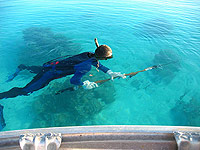
|
||||||||
|
Information Sheet - Bycatch in recreational fishing
It’s great to catch fresh fish, but sometimes you can catch animals you don’t want or need: bycatch.
Below are some simple steps to avoid bycatch.
Recreational fishing is one of the most popular leisure activities in Australia, with more than 4.5 million Australians going fishing every year. This includes angling with hook and line, beach seining, spear fishing, crab and lobster pots and cast-netting. Recreational fishers can accidentally catch species they don’t want, bycatch. The bycatch of recreational fishing includes catching finfish, sharks or stingrays that you don’t want to or can’t keep due to bag limits and legal sizes. Bycatch sometimes also includes birds, marine mammals (dolphins, seals), or sea turtles that can get caught unintentionally when they try and take the bait from hooks or lobster pots or get tangled in the fishing line or nets. While bycatch may be a rare event for an individual fisher, given the number of recreational fishers in Australia many animals can be caught and this could have an impact on their populations and the marine environment. Most fishers would rather avoid catching animals they don’t want or need. |
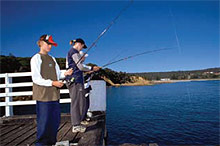 Recreational fishers. (courtesy DAFF) |
|
Cast-netting, a popular recreational pastime. (courtesy of Keith Stewart via Flickr) |
Be a responsible fisher By taking some simple steps when fishing, you can avoid bycatch or if you catch it, you can reduce the harm done. In general:
|
Fishers often catch finfish, sharks or stingrays they don’t want to keep. This can be because it is a species they didn’t want to catch, it is not an edible fish or because of bag limits and legal sizes. Catch and release fishing has also become an increasingly popular practice among many anglers. In catch and release fishing, fishers release fish they could legally keep, and while this isn’t bycatch, similar principles apply in terms of ensuring these fish survive. These fish are part of the marine ecosystem and some may be fish you want to catch in the future.
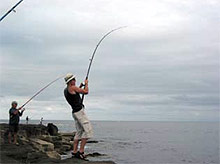 Rock fishing, Broulee. (courtesy James Larcombe, BRS) |
To help these animals survive you can:
|
The Fisheries Research and Development Corporation, Australian National Sportfishing Association and Recfish Australia have initiated a national strategy, Gently does it, to improve the understanding of and increase the survival rate of released line caught fish. It provides more information about fish friendly gear and handling practises to increase survival.
Seabirds
Volunteer organisations, such as the Australian Seabird Rescue and Wildlife Rescue groups, work to save and rehabilitate injured seabirds. During the past 14 years Australian Seabird Rescue has observed that nearly all the fishing-related injuries to shorebirds, such as pelicans, seagulls and terns, appear to have happened during fishing and are not due to lost equipment. To avoid catching birds:
|
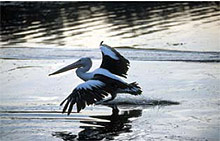 Pelican. (courtesy DEW) |
- do not cut the line, but try to gently reel in the trapped bird;
- cover the bird’s head and if possible remove the hook;
- if the hook can’t be removed without causing further injury or if the bird escapes, seek assistance from a local wildlife group.
Sea lions
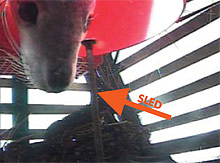 A Sea Lion Excludion Device (SLED) stopping a sea lion from entering a lobster pot in Western Australia. (courtesy of Department of Fisheries, WA) |
Recreational fishers use lobster pots to catch rock lobsters in southern Australian waters. Interactions with seals and sea lions, while rare, are known to happen in commercial lobster pot fisheries and also are possible in recreational fisheries. Seals and sea lions can be attracted to lobster pots and try and take the bait from them. In Western Australia, a small population of the vulnerable Australian sea lion species lives in the same area as the fishing grounds for lobster. Interactions between sea lions and rock lobster pots have occurred over many years and small sea lion pups can become trapped in pots and drown. To stop these accidental drowning Sea Lion Exclusion Devices (SLEDs) have been developed and trialled with fishers. The SLEDs prevent the sea lions from entering the pot but still allow the pot to catch lobsters. From July 2006, SLEDs must be fitted in all rock lobster pots, both commercial and recreational in the area near the sea lion colony. |
Find out more
• Get hooked: Its fun to fish (PIRSA)
• Gently does it, National Released Fish Survival Strategy:
www.info-fish.net/releasefish• Australian Seabird Rescue:
www.seabirdrescue.org• NSW Department of Primary Industries, Fisheries: Responsible fishing to reduce wildlife injuries:
www.fisheries.nsw.gov.au/data/assets/pdf_file/4834/Responsible-fishing- to-reducewildlife-injuries.pdf• Catch and release fishing:
www.fisheries.nsw.gov.au/recreational/saltwater/saltwater/catch-and-release_fishing
Spearfishing is another popular
recreational pastime.
(courtesy of Don and Elaine via Flickr)
www.pir.sa.gov.au/pages/fisheries/get_hooked/index.htm:sectID=1998&tempID=1• Sea Lion Exclusion Devices, Department of Fisheries Western Australia
www.fish.wa.gov.au/docs/pub/SeaLoinExclusionDevices/index.php?0200
Acknowledgements
This information in this sheet has been complied using the expertise and support from a number of sources. Catch and release fish for the future produced by NSW DPI Fisheries Conservation Technology Unit; Gently does it, the National Released Fish Survival website; Responsible fishing to reduce wildlife injuries produced by NSW DPI Fisheries and Australian Seabird Rescue; Sea lion exclusion devices: A how-to guide for commercial and recreational fishers produced by the Department of Fisheries Western Australia; Get hooked: it’s fun to fish from the Department of Primary Industries and Resources, SA.

